When is the collared pigeon breeding season? How can you recognize the bird? You can find this and many other interesting information and pictures in our species portrait.
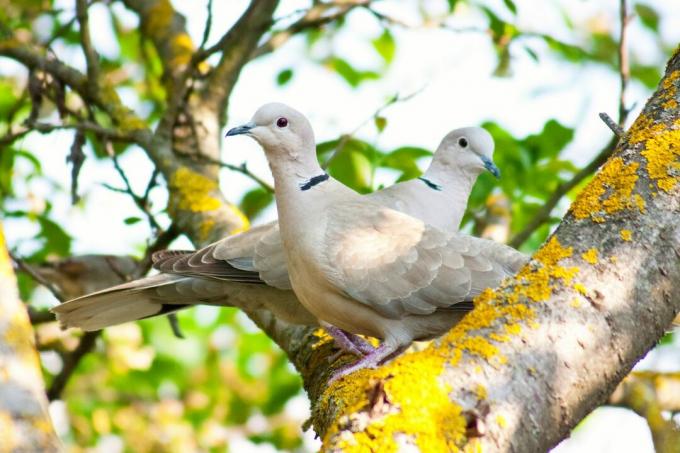
The Collared Pigeon (Streptopelia decaocto) is next to the wood pigeon the second most common wild pigeon in our home gardens. Similar to its relatives, the collared pigeon can also be heard from afar - its dull, calling song often echoes through towns and settlements during the breeding season. The collared pigeon got its name because it was introduced in the 1930s from south-eastern Europe - among other things also from Turkey - came to us and in the following decades in Western and Northern Europe spread. Originally, however, the collared pigeon comes from Asia, from where it gradually made its way towards Europe. How to recognize the wild pigeon both by its appearance and its characteristic song and how you you can support them in your own garden, you can find out more about them here in our large profile collared pigeon.
"Contents"
- Collared Dove: Wanted Poster
-
How to recognize the collared pigeon
- How does the collared pigeon song sound?
- How do you recognize a collared pigeon fledgling?
- What do collared pigeon eggs look like?
- Which habitat does the collared pigeon prefer?
- Where does the collared pigeon build its nest?
- When is the collared pigeon breeding season?
- Where does the collared pigeon spend the winter?
-
Support the collared pigeon in the garden: That's how it works
- What Do Collared Pigeons Eat?
- Are nesting aids appropriate for collared pigeons?
- How can you provide additional support for the collared pigeon?
Collared Dove: Wanted Poster
| size | 29-33 cm |
| Weight | 150-200g |
| breeding season | March – November |
| lifespan | Up to 12 years |
| habitat | Cities, settlements, parks and gardens |
| feed preference | seeds, grains and berries |
| threats | decline in food and habitat |
How to recognize the collared pigeon
Collared pigeons are a bit slimmer and more delicate than the closely related wood pigeons. Their plumage is light grey-beige. The wingtips are slightly brownish and the wingtips are dark in color. The most distinctive feature of the Collared Pigeon is a dark neck stripe. Male and female animals are colored the same and cannot be distinguished visually.
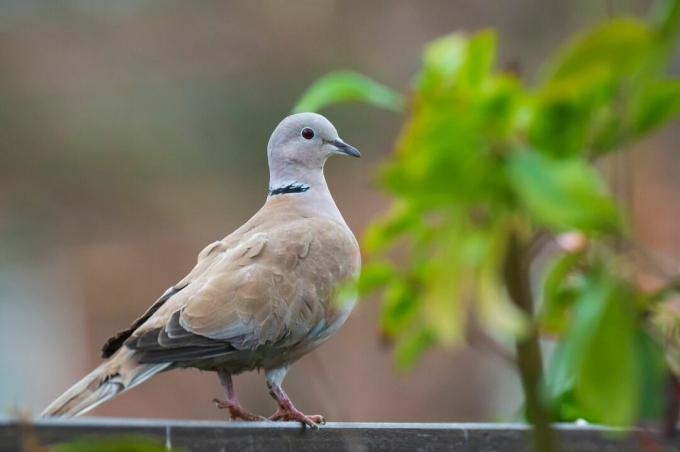
How does the collared pigeon song sound?
The cooing song of the collared pigeon sounds like a dull "Gu-guuh-guh" stressed on the second syllable. The motif of the wood pigeon has a very similar sound, but consists of five syllables instead of three.
The collared pigeon song sounds like this:
How do you recognize a collared pigeon fledgling?
Young collared pigeons do not yet look as elegant as their parents. Their plumage is a dull brown and lacks the characteristic nape stripe. However, this youth dress is lost quite quickly. After just a few weeks, collared pigeons are completely colored and after three to four months they can even start their own brood.
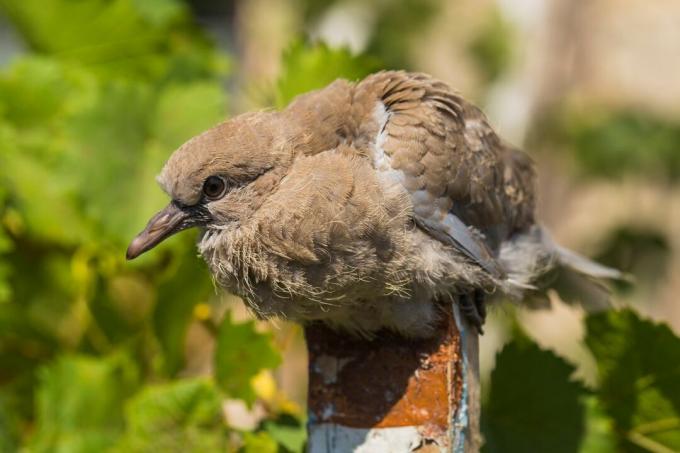
What do collared pigeon eggs look like?
The collared pigeon's eggs are about 3 cm long and pure white. The female almost always lays two eggs per clutch in a nest made of small twigs. The nest and the brood are sometimes very aggressively defended against nest robbers, for example corvids, and also people.

Which habitat does the collared pigeon prefer?
Collared pigeons are cultural followers and prefer to live in close proximity to humans. They benefit from the food supply in agricultural areas and like to settle in villages, but also in the parks of smaller towns.
Where does the collared pigeon build its nest?
Collared pigeon nests are found in trees, hedges, and other dense vegetation. Preference is given to coniferous trees that are distributed individually or in groups in the landscape. Man-made structures are also used as breeding grounds - for example window sills, flower pots or roofs.

When is the collared pigeon breeding season?
The nesting season of collared pigeons is quite long and lasts on average from March to November. In particularly mild years, however, the elegant birds can breed all year round and then create up to six broods per year. The clutches are incubated for about 14 days before the young birds hatch. The young are then fed in the nest with what is known as crop milk – a substance rich in protein and fat that the adult birds produce themselves.
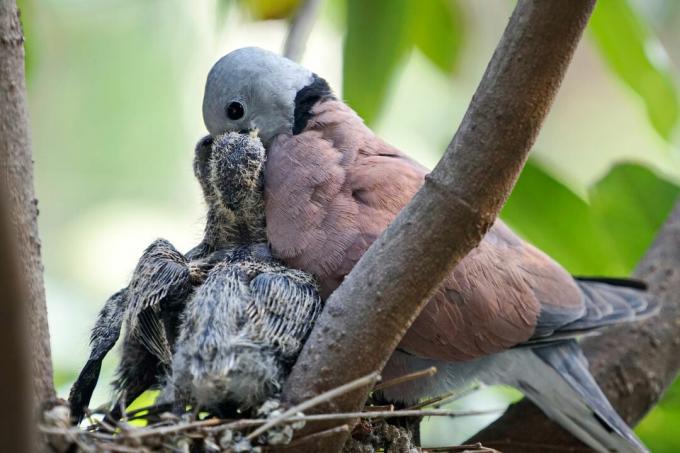
Where does the collared pigeon spend the winter?
Collared pigeons are with us in Central Europe sedentary birds. This means that they do not migrate south in winter, but also spend the cold season in their breeding areas. During this time they can sometimes be observed in small groups together with wood pigeons or feral domestic pigeons. Most of the time, however, they travel in pairs.

Support the collared pigeon in the garden: That's how it works
Since the collared deaf is a culture follower, they are almost exclusively to be found in close proximity to humans. Here you can find out how you can offer wild birds a welcome home in your garden.
What Do Collared Pigeons Eat?
Collared pigeons have a purely plant-based diet. They use a variety of berries, seeds and various types of grain in agriculture. They also like to visit feeding stations, where they eat mixtures of grains, sunflower seeds and other seeds. A feeding station in the garden is a great way to support collared pigeons.

For example, you can offer our Plantura all-season feed, which provides domestic pigeons and many other garden birds with nutritious, selected ingredients all year round.

Plantura year-round food for wild birds
High-protein year-round bird food
for all grain and soft feed eaters,
supports bird parents & their offspring
Are nesting aids appropriate for collared pigeons?
Classic nesting boxes as they are made for blue tits or nuthatch attaches, are out of the question for collared pigeons. Nevertheless, you can create suitable breeding grounds in your garden by, for example, hedges and Trees are not thinned out too much - a potential nest is good in dense vegetation hidden.
How can you provide additional support for the collared pigeon?
In addition to keeping birdseed ready, you can also provide natural food in your garden. In our special article on the topic "Bird friendly gardenFor example, you will find lots of berry-bearing plants that the collared pigeons can feast on. In summer and during the breeding season, a watering hole is also extremely helpful. For the production of the crop milk, the parent birds need a lot of water, which you can easily offer in a bird bath in the form of a flat bowl or a trivet. On hot days, such a drinking trough also serves as a refreshing bird bath.
Notice: However, make sure you clean yours regularly bird bath. Especially when the temperatures are high, the water point should be cleaned every day.
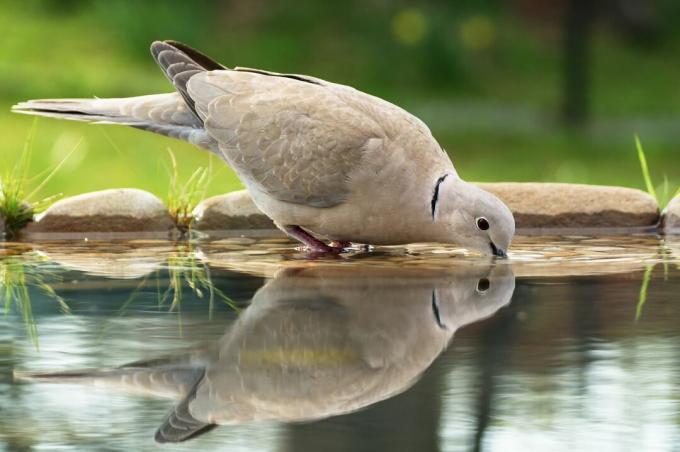
Another type of bird that is mainly vegetarian and can be lured into the garden with birdseed is the Serin. Get to know this garden bird a little better in our species portrait.
...and receive concentrated plant knowledge and inspiration directly in your e-mail inbox every Sunday!



